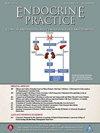科罗拉多州社区Virta干预(VICTOR)改善农村社区糖尿病和心血管风险的试点研究-初步结果。
IF 3.7
3区 医学
Q2 ENDOCRINOLOGY & METABOLISM
引用次数: 0
摘要
目的:结合当地社区卫生工作者(CHWs)和数字卫生的创新策略可能改善农村社区2型糖尿病(T2D)的护理和心血管风险。开展一项集群随机、开放标签、多站点的研究,以评估在科罗拉多州心脏健康解决方案(CHHS)项目中由CHW服务的农村社区中,与单独CHHS相比,转诊到数字持续护理干预(CCI)可改善T2D患者的血红蛋白A1c (A1c)。方法:CHHS项目中患有t2dm且至少服用1种降糖药物、A1c≥7.5%、体重指数≥25 kg/m2并提供电子知情同意书的成人,随机分为CHHS组和CCI+CHHS组。主要终点是A1c从基线到1期结束(3个月)的变化。结果:51人有可评估的数据。平均±SD年龄59.6±10岁,基线体重指数34.4±7 kg/m2, A1c 8.9±1.3%。两组患者的糖化血红蛋白较基线无显著变化。然而,从基线到1期结束,CHHS组的A1c下降了-1.2%,CCI+CHHS组的A1c下降了-1.5%,两组的P < 0.001。CCI+CHHS患者体重减轻5%或以上的比例较高(P < 0.05),抗高血糖药物的数量和/或剂量的净减少显著(P < 0.05)。结论:结合CHW计划和转介到CCI并没有导致更大的A1c降低,但在农村地区的T2D患者中,A1c、体重和药物负担得到改善。本文章由计算机程序翻译,如有差异,请以英文原文为准。
Virta Intervention in CommuniTies in ColORado (VICTOR) Pilot Study to Improve Diabetes and Cardiovascular Risk in Rural Communities - Primary Results
Objective
Innovative strategies combining local community health workers (CHWs) and digital health may improve type 2 diabetes (T2D) care and cardiovascular risk in rural communities. To conduct a cluster-randomized, open-label, multisite study to evaluate the hypothesis that in rural communities served by CHW in the Colorado Heart Healthy Solutions (CHHS) program, referral to a digital continuous care intervention (CCI) would improve hemoglobin A1c (A1c) in patients with T2D as compared with CHHS alone.
Methods
Adults in the CHHS program with T2D taking at least 1 antihyperglycemic medication, A1c ≥ 7.5%, body mass index ≥25 kg/m2 and who provided electronic informed consent were cluster-randomized to CHHS vs CCI+CHHS. The primary outcome was change in A1c from baseline to end of phase 1 (3 months).
Results
Fifty-one individuals had evaluable data. Mean ± SD age was 59.6 ± 10 years, body mass index 34.4 ± 7 kg/m2, and A1c 8.9 ± 1.3% at baseline. The change in A1c from baseline was not significant between groups. However, A1c decreased from baseline to end of phase 1 by −1.2% in CHHS and −1.5% in CCI+CHHS, P < .001 in each group. A higher proportion of individuals in CCI+CHHS achieved 5% or greater weight loss (P < .05), and significant net decrease in number and/or dose of antihyperglycemic medications (P < .05).
Conclusions
Combining a CHW program with referral to CCI did not result in greater A1c reduction, but led to improvements in A1c, weight, and medication burden in individuals with T2D in a rural setting.
求助全文
通过发布文献求助,成功后即可免费获取论文全文。
去求助
来源期刊

Endocrine Practice
ENDOCRINOLOGY & METABOLISM-
CiteScore
7.60
自引率
2.40%
发文量
546
审稿时长
41 days
期刊介绍:
Endocrine Practice (ISSN: 1530-891X), a peer-reviewed journal published twelve times a year, is the official journal of the American Association of Clinical Endocrinologists (AACE). The primary mission of Endocrine Practice is to enhance the health care of patients with endocrine diseases through continuing education of practicing endocrinologists.
 求助内容:
求助内容: 应助结果提醒方式:
应助结果提醒方式:


